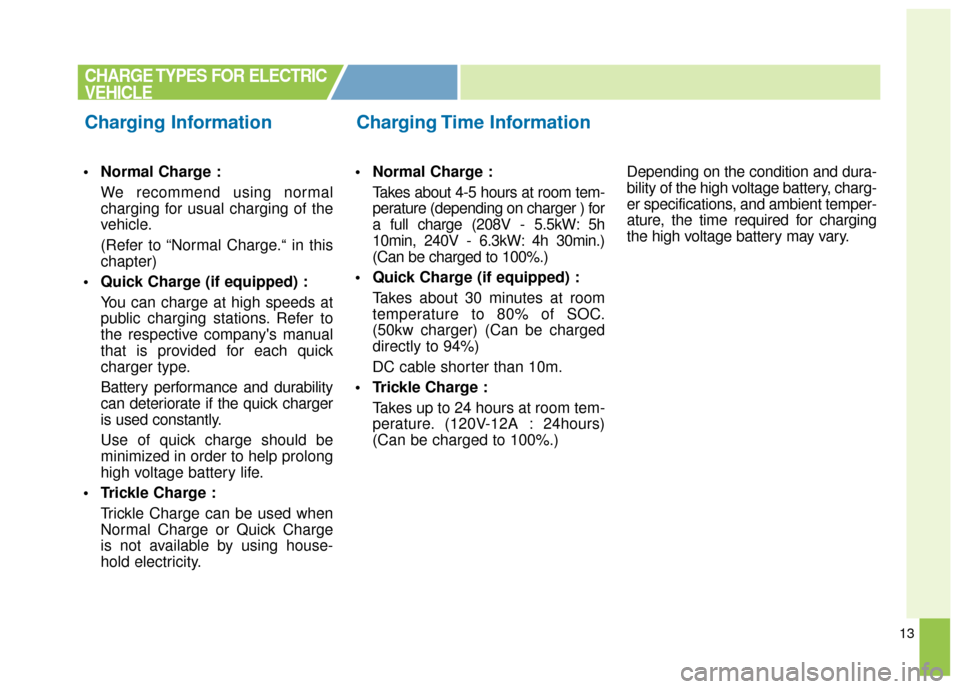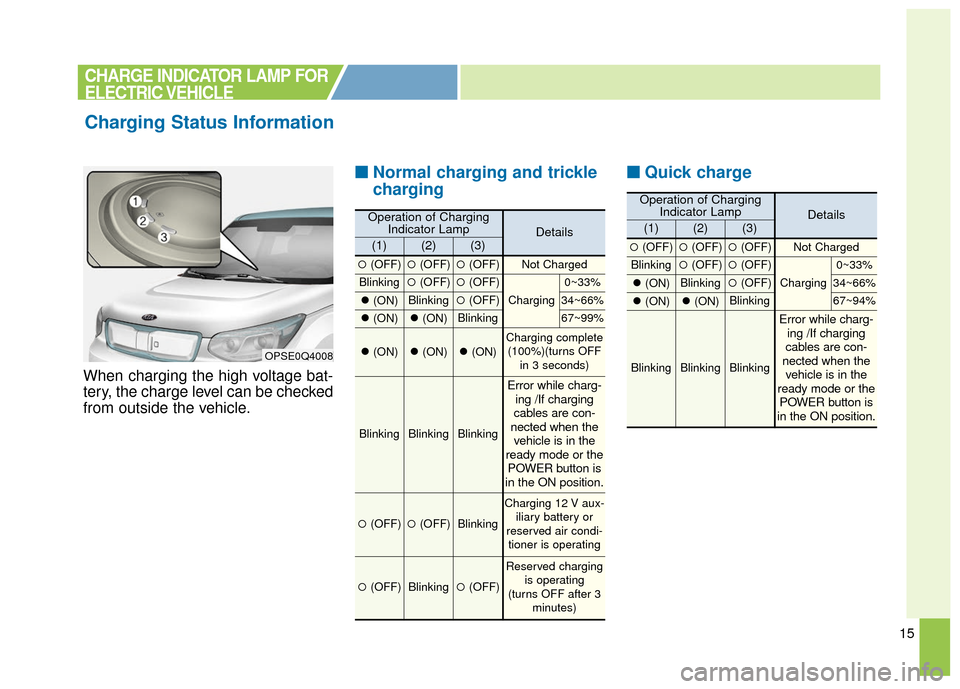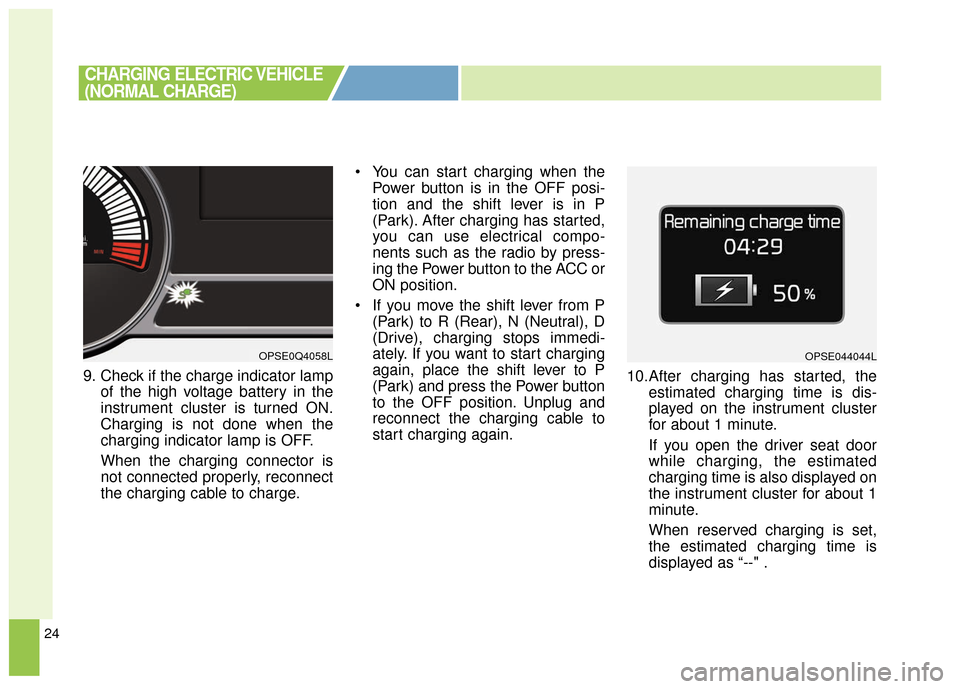Page 421 of 470
11
■ ■Set Climate Times
This is a feature that automatically
starts climate control on the reserved
day and time along with the tempera-
ture designated by the user. Two sep-
arate reservations can be set.
■ ■EV Setting
You can change the EV warning alarm.
� � Warning Settings
–Low battery warning : You can
select several battery levels at
which to display an alarm mes-
sage.
– Frequency : You can select the
repetition interval to display the
Low battery warning.
Description
When selecting the list again, change
the setting.
If you do not want use the reserved
setting, select OFF.
NameDescription
Vehicle
Departure TimeEnter the anticipated depar-
ture time for the vehicle.
Set
TemperatureEnter the temperature that
you desire.
Repeat Day of
WeekSelect the day of the week
you wish to reserve for
automatic air conditioning.
EV MODE
Page 423 of 470

13
Normal Charge :We recommend using normal
charging for usual charging of the
vehicle.
(Refer to “Normal Charge.“ in this
chapter)
Quick Charge (if equipped) : You can charge at high speeds at
public charging stations. Refer to
the respective company's manual
that is provided for each quick
charger type.
Battery performance and durability
can deteriorate if the quick charger
is used constantly.
Use of quick charge should be
minimized in order to help prolong
high voltage battery life.
Trickle Charge : Trickle Charge can be used when
Normal Charge or Quick Charge
is not available by using house-
hold electricity. Normal Charge :
Takes about 4-5 hours at room tem-
perature (depending on charger ) for
a full charge (208V - 5.5kW: 5h
10min, 240V - 6.3kW: 4h 30min.)
(Can be charged to 100%.)
Quick Charge (if equipped) : Takes about 30 minutes at room
temperature to 80% of SOC.
(50kw charger) (Can be charged
directly to 94%)
DC cable shorter than 10m.
Trickle Charge : Takes up to 24 hours at room tem-
perature. (120V-12A : 24hours)
(Can be charged to 100%.) Depending on the condition and dura-
bility of the high voltage battery, charg-
er specifications, and ambient temper-
ature, the time required for charging
the high voltage battery may vary.
CHARGE TYPES FOR ELECTRIC
VEHICLE
Charging Information Charging Time Information
Page 424 of 470
14
CHARGE TYPES FOR ELECTRIC
VEHICLE
Charging Types
CategoryCharging Inlet(Vehicle)Charging ConnectorCharging OutletHow to ChargeCharging Time
Normal
Charge
Use the normal
charger that is
installed in your
home or public
charging stationApprox. 4-5 hours
(208V - 5.5kW: 5h
10min, 240V - 6.3kW:
4h 30min. room tem-
perature) (Can be
charged to 100% )
Quick
Charge
(if equipped)Use the quick
charger at public
charging stationApprox. 33 min
(50 kW, room tem-
perature) (Can be
charged to 94%)
Trickle
ChargeUse household
electricity
Approx. 24hours
(120V-12A: 24hours,
room temper-ature)
(Can be charged to
100%)
OPSE0Q4035
OPSE0Q4036
OPSE0Q4035
OPSE0Q4005
OPSE0Q4006
OPSE0Q4005
OPSE0Q4057N
OPSE0Q4004
OPSE0Q4007
❈Shape of charger and how to use the charger may be different for each manufacturer.
❈ Depending on the condition and durability of the high voltage battery, charger specifications, and ambient temper-
ature, the time required for charging the high voltage battery may vary.
Page 425 of 470

15
When charging the high voltage bat-
tery, the charge level can be checked
from outside the vehicle.
■ ■Normal charging and trickle
charging ■ ■
Quick charge
Charging Status Information
OPSE0Q4008
CHARGE INDICATOR LAMP FOR
ELECTRIC VEHICLE
Operation of Charging
Indicator LampDetails(1)(2)(3)
�(OFF)�(OFF)�(OFF)Not Charged
Blinking�(OFF)�(OFF)
Charging
0~33%
�(ON)Blinking�(OFF)34~66%
�(ON)�(ON)Blinking67~99%
�(ON)�(ON)�(ON)Charging complete
(100%)(turns OFF in 3 seconds)
BlinkingBlinkingBlinking
Error while charg-ing /If charging
cables are con-
nected when the vehicle is in the
ready mode or the POWER button is
in the ON position.
�(OFF)�(OFF)Blinking
Charging 12 V aux-
iliary battery or
reserved air condi- tioner is operating
�(OFF)Blinking�(OFF)
Reserved charging is operating
(turns OFF after 3 minutes)
Operation of ChargingIndicator LampDetails(1)(2)(3)
�(OFF)�(OFF)�(OFF)Not Charged
Blinking�(OFF)�(OFF)
Charging
0~33%
�(ON)Blinking�(OFF)34~66%
�(ON)�(ON)Blinking67~94%
BlinkingBlinkingBlinking
Error while charg-
ing /If charging
cables are con-
nected when the vehicle is in the
ready mode or the POWER button is
in the ON position.
Page 427 of 470
17
RESERVED CHARGING
To immediately charge the battery
(not at reserved time only) first con-
nect the charging cables. Then, the
Deactivate Reserved Charge button
[ ] should be pressed within three
minutes after the cable connection.
If the battery does not charge after
the Deactivate Reserved Charge
button [ ] has been pressed,
remove the charging cable and
reconnect it.After the Deactivate Reserved
Charge button [ ] has been pressed
(pressed position), you can charge
the battery at any given time.
To change the status to reserved
charging, please press the
Deactivate Reserved Charge button
[ ] again (not pressed position).
❈
Refer to "Normal Charge, Trickle
Charge" for details about connect-
ing the normal charger and the
portable charging cable (ICCB: In-
Cable Control Box).
OPSE0Q40013
Page 431 of 470
21
Always keep the charging connec-tor and charging plug in clean and
dry condition. Be sure to keep the
charging cable in a condition
where there is no water or mois-
ture.
Make sure to use the designated charger for charging the electric
vehicle. Using any other charger
may cause failure.
Before charging the battery, turn the vehicle [OFF].
Be careful not to drop the charging connector. The charging connec-
tor can be damaged.
PRECAUTIONS FOR CHARGING
ELECTRIC VEHICLE
WARNING - Cooling fan
Do not touch the cooling fan
while vehicle is charging. When
the vehicle is switched [OFF]
while charging, the cooling fan
inside the motor compartment
may automatically operate.
Page 434 of 470

24
9. Check if the charge indicator lampof the high voltage battery in the
instrument cluster is turned ON.
Charging is not done when the
charging indicator lamp is OFF.
When the charging connector is
not connected properly, reconnect
the charging cable to charge. You can start charging when the
Power button is in the OFF posi-
tion and the shift lever is in P
(Park). After charging has started,
you can use electrical compo-
nents such as the radio by press-
ing the Power button to the ACC or
ON position.
If you move the shift lever from P (Park) to R (Rear), N (Neutral), D
(Drive), charging stops immedi-
ately. If you want to start charging
again, place the shift lever to P
(Park) and press the Power button
to the OFF position. Unplug and
reconnect the charging cable to
start charging again. 10.After charging has started, the
estimated charging time is dis-
played on the instrument cluster
for about 1 minute.
If you open the driver seat door
while charging, the estimated
charging time is also displayed on
the instrument cluster for about 1
minute.
When reserved charging is set,
the estimated charging time is
displayed as “--" .
OPSE0Q4058LOPSE044044L
CHARGING ELECTRIC VEHICLE
(NORMAL CHARGE)
Page 435 of 470
25
Depending on the condition and
durability of the high voltage battery,
charger specifications, and ambient
temperature, the time required for
charging the battery may vary.11.You may prevent possible charg-
ing cable theft by taking the fol-
lowing steps. Lock the door after
the charging cable is connected,
by pressing the lock button on the
smart key or on the central door
lock switch.
When the door is locked, the
charging connector will become
locked and this will prevent possi-
ble theft.
So, after charging is complete,
you must release the door lock in
order to disconnect the charging
connector.
■ ■Unlock Charging Door in
Emergency
If the charging door does not open
due to battery discharge and failure
of the electric wires, open the hood
and slightly pull the emergency cable
as shown above. The charging door
will then open.
CHARGING ELECTRIC VEHICLE
(NORMAL CHARGE)
OPSE0Q4016